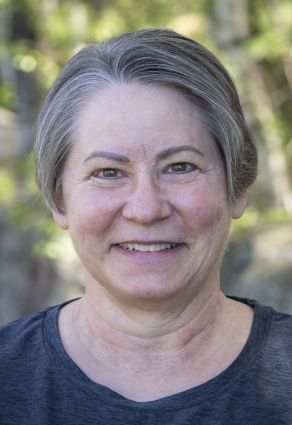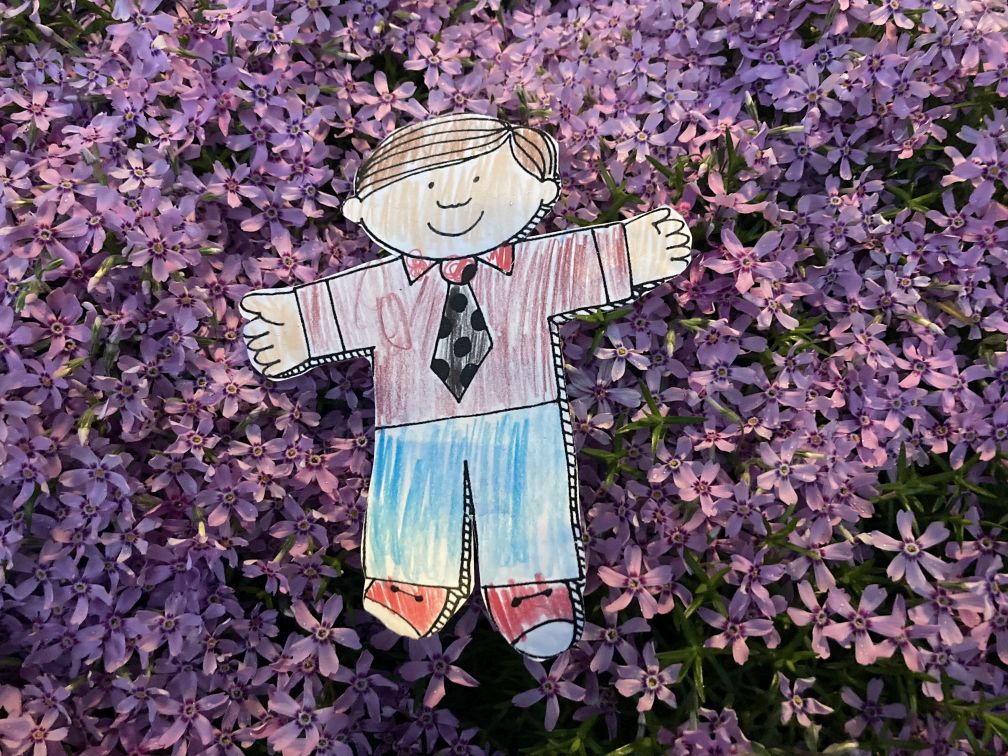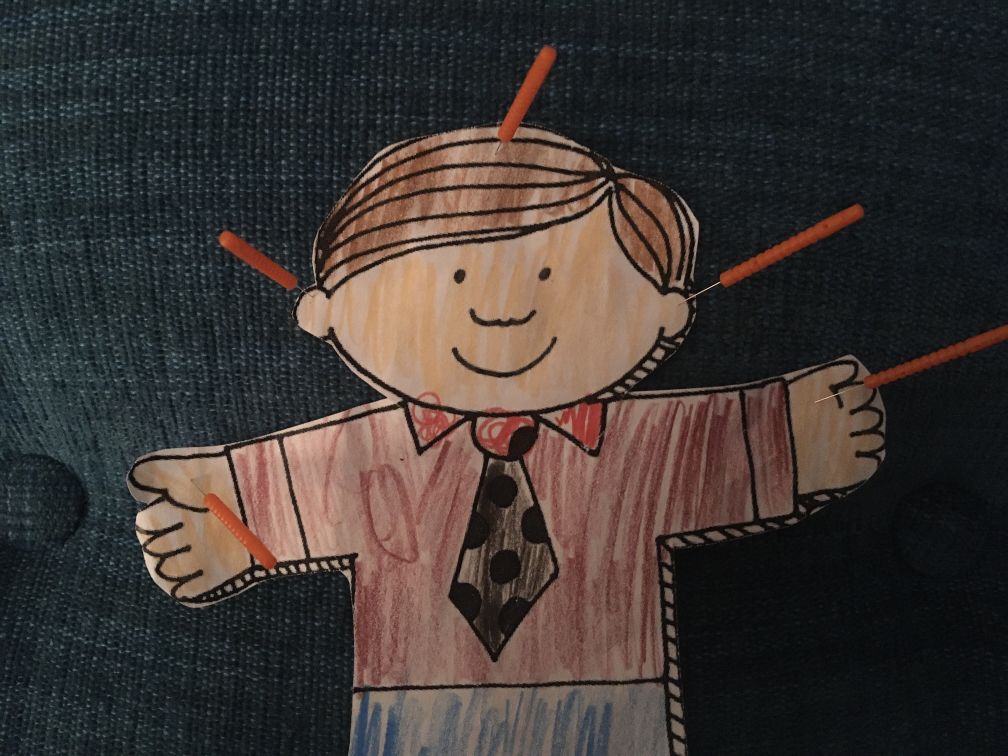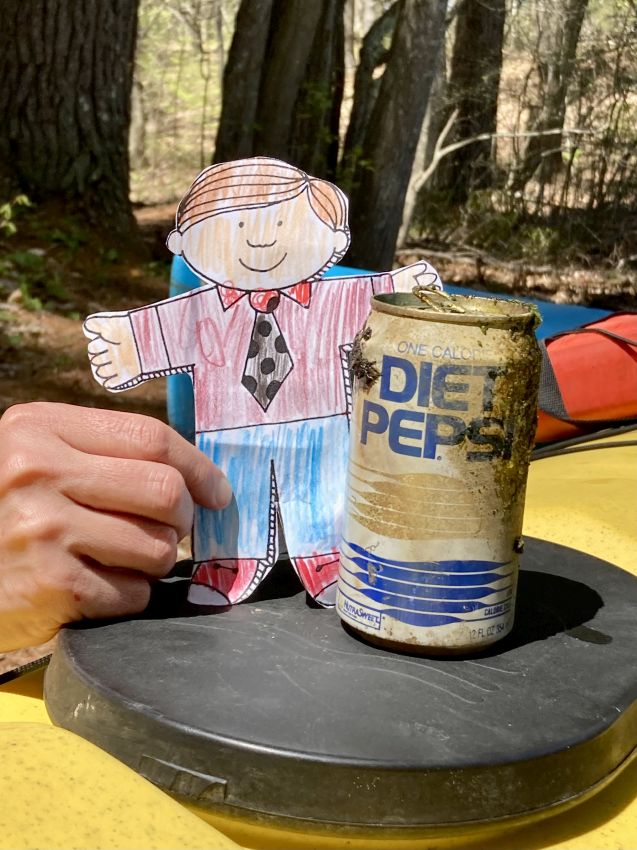by Elizabeth Ropp, LAc.
If you follow MAS on Facebook or if you’ve been in the clinic in the last few weeks, you may have noticed the new edition to our small selection of home care products: ear seeds kits.
We don’t sell many products at MAS. We like to keep it simple. What we do carry at MAS has to be effective.
What are ear seeds?
If you are not familiar with ear seeds, they are acupressure stickers containing a small metal bead or seed. When applied to acupressure points on the ear (or body) it can provide a therapeutic effect. It’s like an acupuncture needle but it doesn’t puncture the skin. It's acupressure.
Ear seeds are growing in popularity. Magazines like Vogue have written articles about ear seeds claiming all kinds of benefits. Many companies are popping up selling ear seeds kits and online classes, which is great! However, we know it can also seem overwhelming for anyone who is new to ear seeds for how to get started.
We’ve tried a number of different ear seeds products over the years and chose good quality seeds that are easy to use and don't cost a lot of money. I also settled on a 4-point ear seed treatment that is effective and easy for anyone to learn and apply. I learned this 4-point combination from my colleague and friend, Laura Cooley. She named it The Don’t Worry, Be Happy treatment.
Why use ear seeds?
In 2020, many patients mentioned how much more anxious they were than usual because of the pandemic. I added ear seeds into many treatments. So many of you gave me great feedback with the addition of the ear seeds.
In the years before the pandemic I volunteered at a shelter near the SNHU arena. I have seen people in acute withdrawal from street drugs find relief with ear seeds. Later, I volunteered at Hope for NH Recovery. Every week, I met with a group of regulars who enjoyed ear acupuncture, ear seeds or both as a way to support long term recovery from Substance Use Disorder.
How to get started
MAS Ear seed kits come with a QR code to our website where you can find a video demonstration that I made of The Don’t Worry, Be Happy treatment along with a curated playlist of other videos to help you get started with your ear seeds practice.
Do you want to take an ear seeds class?
There are many great ear seeds classes available online. We recommend the AcuTherapy Class offered by our colleagues at Public Health Acupuncture New Mexico (PHANM). This class was created by experienced instructors who have brought ear seeds trainings to high schools and public health settings in many communities in New Mexico. The training was made possible through a grant from the Medical Reserve Corps.
Let us know what you think. If you buy our ear seeds kits to treat yourself and your friends and family, please let us know how it goes.
by Elizabeth Ropp, LAc.
For the next month, MAS hosts a food collection drive to support the Acts of Kindness food pantry, which serves our neighbors experiencing homelessness in Manchester, NH.
About Acts of Kindness
Acts of Kindness is a Manchester-based non-profit dedicated to assisting the city's unhoused population. Their mission is powerful: to provide a safe and supportive environment, connect individuals to solutions like housing and treatment and walk with them on their journey. AOK operates from the belief that every individual is worthy of dignity and assistance. By working together, they strive to create a brighter future where no one is left behind.
How Acupuncture Connects Us
Our connection with Acts of Kindness began when MAS acupuncturists Andy and Elizabeth met Tia Elie, AOK's passionate founder, during a 5NP Ear Acupuncture Detoxification Specialists Training held at Hope for NH Recovery.
We were immediately struck by Tia's genuine compassion and the powerful stories she shared about accompanying Manchester's most vulnerable. She's a true advocate, helping people navigate everything from substance use treatment to housing applications.
Tia and her partner, Fadzi, returned to a recent training to share how AOK is actively integrating 5NP ear acupuncture into their outreach. While many programs talk about it, Tia rolls up her sleeves! She hosts pop-up clinics in Manchester's parks to help people struggling with mental health and trauma find immediate relief, function better, and feel more grounded. It’s a beautiful example of using simple, effective tools like 5NP to meet people where they are.

AOK founder Tia Elie, getting 5NP ear acupuncture from Fadzi as he works towards his NH ADS certification.
How You Can Help: 🤝
AOK's food pantry is in urgent need of specific shelf-stable items that are easy for individuals without kitchens or reliable storage to manage.
We are collecting the following items at MAS clinics during clinic hours, through the next month:
- Canned goods with pop-top lids (e.g., canned soups, chili, beans, tuna).
- Individual packaged snacks, especially soft foods (e.g., applesauce pouches, fruit cups, pudding cups).
- Cereal (boxes or individual cups).
- Boxed or shelf-stable milk.
- Gatorade or other drinks with electrolytes.
- Handwarmers
Every donation makes a direct, immediate impact on someone's life.
If you would like to support Acts of Kindness directly with a monetary donation, please visit their website.
Thank you for helping MAS support Tia and the incredible work of Acts of Kindness!
$5 5NP ear acupuncture on Tuesdays 4-6pm at MAS-Manchester
Starting May 20, MAS offers $5 5NP ear acupuncture treatments on Tuesday afternoons at our Manchester location from 4 pm to 6 pm. No appointments needed - this is a walk-in clinic. Please spread the word.
This effort is made possible by a volunteer group of NH-certified Acupuncture Detoxification Specialists (ADS) who completed a state-approved MAS-staffed ear acupuncture training. This dedicated group of ADS wants to be put to work. This initiative supports MAS’s mission making acupuncture as affordable and accessible to as many people as possible.
This well-known, standardized ear acupuncture treatment known as 5NP, has many benefits including:
reducing stress
fostering resilience &
supporting sobriety
5NP is an especially useful tool for people in communities who have experienced a traumatic event, man-made or a natural disaster. This is because stimulation of these five points is an effective way to down-regulate the central nervous system. This can help slow down racing thoughts and a rapid heart rate, helping breathing more deeply and easily.
Check out these great videos to learn more about the benefits of 5NP.
Unimagined Bridges Trailer
Restorative Justice Practices: Ear Acupuncture | UIC Law
Dope Is Death
You can learn more about 5NP Ear Acupuncture Detoxification Specialist Trainings - available to all - through this very website: masnh.org/ears
By Beth Griffey, LAc.
The American Pain Society (in the Journal of Pain, vol 19,
May, 2018) published a review of multiple randomized
acupuncture trials (through 2015) to determine effects of
acupuncture on four chronic pain conditions.
Thirty-nine trials and more than twenty thousand patients were
included. The pain conditions included nonspecific
musculoskeletal pain, osteoarthritis, chronic headache or
shoulder pain. The end results measured were changes in
pain and function.
The conclusions reached by the review are:
1) acupuncture is effective for treating chronic pain,
2) lasting relief of pain and/or improvements in
function persist over time and cannot be simply due
to “the placebo effect”.
At MAS we encourage consistent treatment over
time. This is the best way to work toward treatment
goals over an initial period of days and weeks. After
improvement is demonstrated we ask patients to space
out treatments and monitor the results. I have seen
patients be able to withdraw from treatment for months
and years after achieving and maintaining lasting pain
relief and improved function.
This is exciting news for
those of us who experience and treat chronic pain conditions.
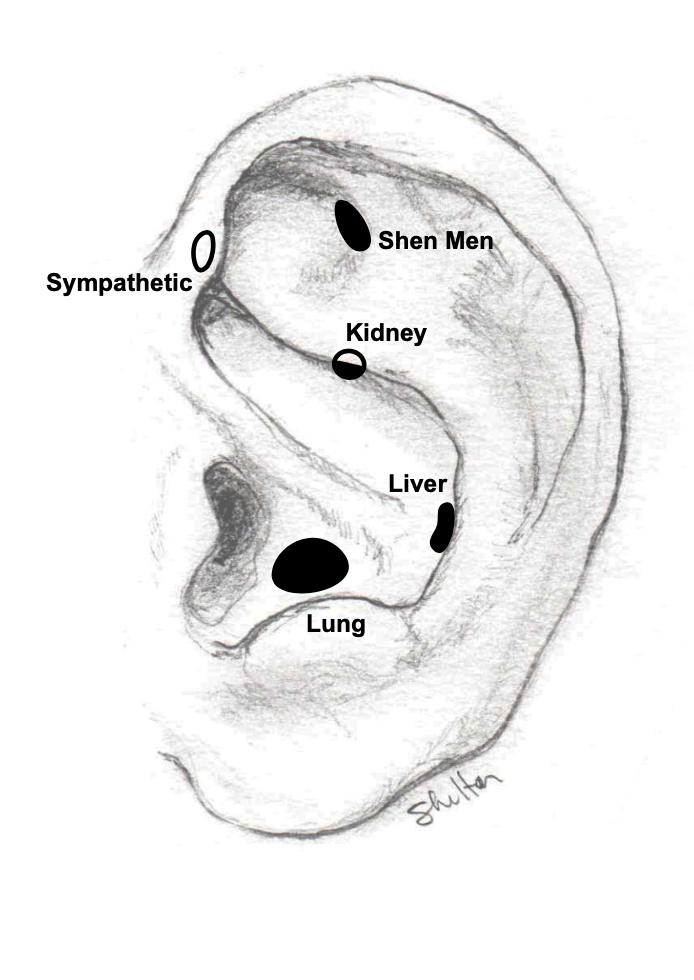
5NP drawing by James Shelton
written by Elizabeth Ropp
If you're curious about recent MAS 5NP ear acupuncture trainings, here's why they matter.
Under New Hampshire law, anyone can become certified as an Acupuncture Detoxification Specialist (ADS) after completing an approved training. MAS offers the Auricular Acupuncture Technician Training in partnership with The People’s Organization of Community Acupuncture (POCA). ADSes can practice under the general supervision of a licensed acupuncturist (LAc) (like us), which includes remote support, biannual site visits, and state recertification every two years.
The 5-point ear acupuncture protocol we teach is akin to first aid. It addresses anxiety, stress, insomnia, and pain management by promoting relaxation and resilience. On its own, ear acupuncture is a powerful tool for supporting mental and behavioral health.
The history of this 5-point protocol reflects its impact on underserved communities. Developed during the heroin and methadone epidemic in the South Bronx in the 1960s, it became a cornerstone of Lincoln Hospital's outpatient program, offering highly effective stigma-free, walk-in treatment. Practitioners trained there have since shared these skills worldwide. This is how we have come to be able to teach these methods ourselves.
Ear acupuncture has been utilized in numerous settings, from disaster recovery (e.g., 9/11, Hurricane Katrina, and the El Paso mass shooting) to drug courts, substance use programs, rural mental health initiatives, prisons, and even support groups for conditions like sickle cell anemia and celiac disease.
Recognized by the Substance Abuse and Mental Health Services Administration (SAMHSA) and endorsed by Indian Health Services (IHS), ear acupuncture is also incorporated into VA centers and hospitals.
At MAS, we share the mission of POCA: making acupuncture affordable and accessible to as many people as possible. Teaching these skills empowers people to use this inexpensive, transformative tool effectively and easily in their communities.








